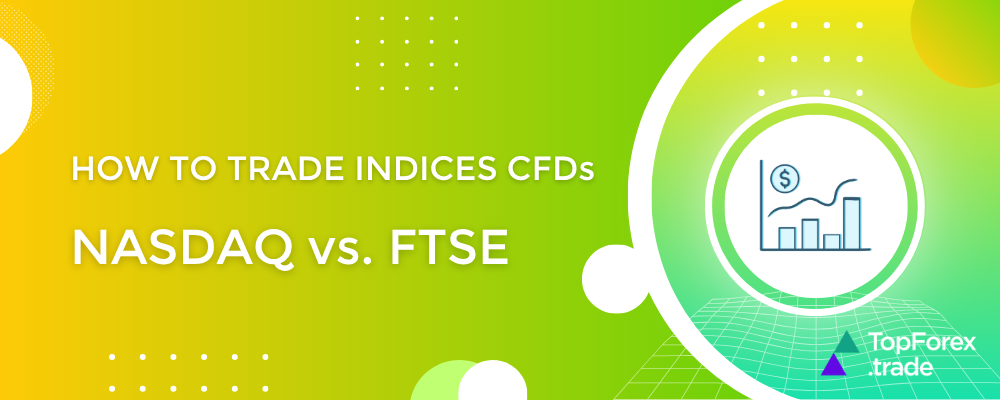How to trade NASDAQ and FTSE 100 CFDs: expert strategies and broker picks

Trading indices CFDs (Contracts for Difference) offers exposure to global markets without owning the underlying assets. Among the most popular indices are the NASDAQ-100 (U.S. tech-driven index) and the FTSE 100 (UK’s diversified blue-chip index).
This in-depth guide will compare NASDAQ vs. FTSE 100 CFDs, analyze key trading strategies, provide real-world examples, and list the best brokers for trading indices in 2025.
NASDAQ vs. FTSE 100: key differences
| Factor | NASDAQ-100 (NDX/US100) | FTSE 100 (UKX) |
|---|---|---|
| Region and focus | U.S. (tech and growth stocks) | UK (financials, commodities, pharma) |
| Volatility | High (earnings, Fed policy, AI trends) | Moderate (BoE rates, commodity prices) |
| Trading hours | 14:30 – 21:00 GMT (pre/post-market available) | 08:00 – 16:30 GMT |
| Top holdings | Apple (AAPL), Microsoft (MSFT), Nvidia (NVDA) | Shell (SHEL), HSBC (HSBA), AstraZeneca (AZN) |
| Average spreads | 0.5 – 2.0 pts (low spread on ECN brokers) | 1.0 – 3.0 pts (wider due to UK market liquidity) |
| Leverage | 1:10 (EU), 1:30 (Global) | 1:10 (EU), 1:20 (Global) |
| Dividend impact | Minimal (tech stocks pay low dividends) | Significant (many FTSE stocks pay high dividends) |
Trading strategies for NASDAQ and FTSE 100 CFDs

A) Trend trading NASDAQ (momentum strategy)
- Best for: Day traders and swing traders
- Why? NASDAQ moves sharply on tech earnings, Fed decisions, and AI trends.
- Example:
- Catalyst: Nvidia reports record AI chip sales → NASDAQ surges.
- Trade: Buy NASDAQ CFD at 19,000 (1 lot = $10 per point).
- Exit at 19,500 → +500 pts = $5,000 profit.
B) Range trading FTSE 100 (support/resistance strategy)
- Best for: Conservative traders
- Why? FTSE 100 often moves between key levels due to stable blue-chip stocks.
- Example:
- Range: FTSE fluctuates between 8,000 (support) and 8,300 (resistance).
- Trade: Sell at 8,250, set stop-loss at 8,350, take profit at 8,100.
- Outcome: FTSE drops to 8,100 → +150 pts = £1,500 profit (per lot).
C) News trading (economic events impact)
| Event | NASDAQ reaction | FTSE 100 reaction |
|---|---|---|
| U.S. Fed rate decision | High volatility (tech stocks sensitive) | Moderate impact |
| UK inflation data | Minimal impact | Sharp moves (BoE policy influence) |
| Tech earnings (e.g., Apple) | Huge gap up/down | Minor effect |
| Oil price surge | Mixed (some tech impact) | Strong rally (BP, Shell Boost FTSE) |
Risk management in index CFD trading
- Use stop-loss orders: Always set SL (e.g., 1-2% of account per trade).
- Avoid over-leverage: NASDAQ’s volatility can wipe accounts fast at 1:100+ leverage.
- Hedging: Trade correlated assets (e.g., Long NASDAQ + Short FTSE if U.S. outperforms UK).
More about: Forex risk management tools: automatic trading with popular market orders
Top 5 CFD brokers for NASDAQ & FTSE 100 trading
BlackBull Markets
- Regulation: FMA (NZ), FSA (Seychelles)
- Spreads: From 0.0 pts (NASDAQ), 0.8 pts (FTSE 100)
- Leverage: Up to 1:500 (Global Clients)
- Platforms: MT4, MT5, BlackBull Trade
- Pros: Best for scalping, ECN pricing, no dealing desk.
XTB
- Regulation: FCA (UK), CySEC, KNF
- Spreads: From 0.5 pts (NASDAQ), 1.2 pts (FTSE)
- Leverage: 1:30 (Retail), 1:100 (Pro)
- Platforms: xStation 5 (Advanced Charts + Free Webinars)
- Pros: No commission on indices, best research tools.
eToro
- Regulation: FCA, CySEC, ASIC
- Spreads: 1.0 pt (NASDAQ), 1.5 pts (FTSE)
- Leverage: 1:20 (EU), 1:30 (Global)
- Platforms: eToro App (Copy Top Traders Automatically)
- Pros: Social trading, beginner-friendly.
Risk disclaimer: eToro is a multi-asset platform which offers both investing in stocks and cryptoassets, as well as trading CFDs.
CFDs are complex instruments and come with a high risk of losing money rapidly due to leverage. 61% of retail investor accounts lose money when trading CFDs with this provider. You should consider whether you understand how CFDs work, and whether you can afford to take the high risk of losing your money.
This communication is intended for information and educational purposes only and should not be considered investment advice or investment recommendation. Past performance is not an indication of future results.
Copy Trading does not amount to investment advice. The value of your investments may go up or down. Your capital is at risk.
Don’t invest unless you’re prepared to lose all the money you invest. This is a high-risk investment and you should not expect to be protected if something goes wrong. Take 2 mins to learn more.
eToro USA LLC does not offer CFDs and makes no representation and assumes no liability as to the accuracy or completeness of the content of this publication, which has been prepared by our partner utilizing publicly available non-entity specific information about eToro.
AvaTrade
- Regulation: Central Bank of Ireland, ASIC, FSCA
- Spreads: fixed 1.5 pts (NASDAQ), 2.0 pts (FTSE)
- Leverage: 1:400 (Global)
- Platforms: MT4, MT5, AvaTradeGO
- Pros: Great for algo traders, reliable execution.
Plus500
- Regulation: FCA, ASIC, CySEC
- Spreads: 0.6 pts (NASDAQ), 1.0 pts (FTSE)
- Leverage: 1:30 (Retail)
- Platforms: WebTrader (User-Friendly)
- Pros: Simple platform, no hidden fees.
82% of retail investor accounts lose money when trading CFDs with this provider. You should consider whether you can afford to take the high risk of losing your money.
Related articles:
NASDAQ vs. FTSE 100 CFDs trading - FAQ